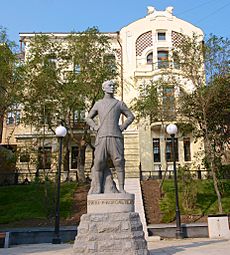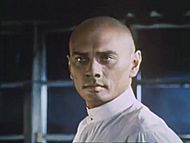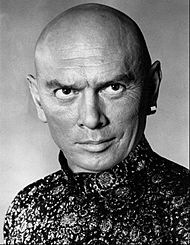Yul Brynner facts for kids
Quick facts for kids
Yul Brynner
|
|
|---|---|
| Юл Бринер | |
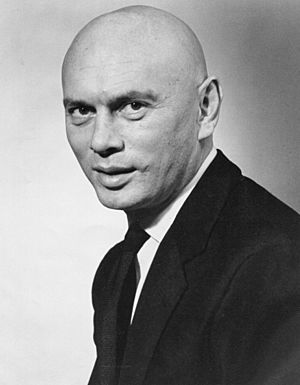
Brynner in 1960
|
|
| Born |
Yuliy Borisovich Briner
July 11, 1920 |
| Died | October 10, 1985 (aged 65) New York City, U.S.
|
| Resting place | Saint-Michel-de-Bois-Aubry Russian Orthodox Monastery (near Luzé, France) |
| Citizenship |
|
| Occupation | Actor |
| Years active | 1941–1985 |
| Spouse(s) |
Doris Kleiner
(m. 1960; div. 1967)Jacqueline Thion de la Chaume
(m. 1971; div. 1981)Kathy Lee
(m. 1983) |
| Children | 5 |
| Awards |
|
Yul Brynner (born Yuliy Borisovich Briner; July 11, 1920 – October 10, 1985) was a famous actor from Russia. He is best known for playing King Mongkut in the musical The King and I. He won two Tony Awards for this role on stage. Later, he won an Academy Award for Best Actor for the movie version.
Brynner played the King 4,625 times on stage. He became famous for his shaved head, which he kept even after the musical. He was one of the first Russian-American film stars. In 1956, his handprints were placed in front of Grauman's Chinese Theatre in Hollywood. He also received a star on the Hollywood Walk of Fame in 1960.
In 1956, Brynner won an award for his roles in The Ten Commandments and Anastasia. He was also well-known as the gunman Chris Adams in The Magnificent Seven (1960). He also played the robot "The Gunslinger" in Westworld (1973). Besides acting, he was a model, photographer, and author.
Contents
Early Life and Family Background
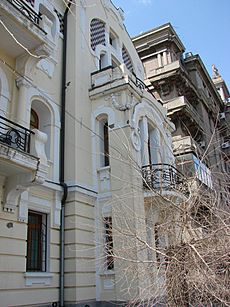
Yul Brynner was born Yuliy Borisovich Briner on July 11, 1920. His birthplace was Vladivostok, Russia. His family had roots from Switzerland, Germany, Russia, and Buryat (Mongol) people. He also had some Romani heritage.
He was born in a large, four-story house in Vladivostok. His family was wealthy. They owned land and developed silver mines in Siberia and the Far East. When Yul was born, Vladivostok was part of the Far Eastern Republic. It was also partly controlled by Japan.
In 1922, the Red Army took over Vladivostok. Much of his family's wealth was taken by the government. They lost ownership of their home. However, Yul, his older sister Vera, and their mother continued to live there for a while.
Later in life, Brynner sometimes told fun, exaggerated stories about his past. He would claim he was born on a Russian island. His son, Rock Brynner, wrote a book in 1989 that cleared up some of these stories.
Yul's father, Boris Yuliyevich Briner, was a mining engineer. He was of Swiss-German and Russian descent. His grandfather, Jules Briner, was Swiss. He moved to Vladivostok in the 1870s and started a successful business. Yul's grandmother was from Irkutsk and had some Buryat ancestry.
Yul's mother, Marousia Dimitrievna, was from an educated Russian family. She studied to be an actress and singer. She was said to have Russian Romani ancestry. Yul felt a strong connection to the Romani people. In 1977, he became the honorary president of the International Romani Union. He held this title until he passed away.
In 1922, after the Soviet Union was formed, Yul's father had to give up his Swiss citizenship. All family members became Soviet citizens. His father's job required a lot of travel. In 1923, he met and fell in love with an actress named Katerina Ivanovna Kornakova. She later helped Yul get acting work in America. In 1924, Yul's parents divorced. His father continued to support Yul and his sister.
Life in China, France, and Switzerland
In 1927, Yul, his mother, and his sister Vera moved from Russia to Harbin, China. Yul and Vera went to a school run by the YMCA there.
In 1930, Yul's father gave him an acoustic guitar for his birthday. This gift and later music lessons greatly influenced Yul. He became very interested in learning the guitar technique and studying music. His sister Vera, who was an opera singer, helped him learn. After several years, Yul became a skilled guitar player and singer.
In 1933, fearing war between China and Japan, Yul, Vera, and their mother moved to Paris, France. On June 15, 1935, when he was 14, Yul performed for the first time at a cabaret in Paris. He played his guitar and sang in Russian and Romani languages. He continued to perform in Parisian nightclubs. Sometimes he sang Russian and Romani songs with his sister.
Yul also studied French at a school in Paris. In 1936, he worked as a lifeguard. He then joined a French circus and trained as a trapeze acrobat. He worked with the circus for several years. However, he had to leave due to a back injury that caused him much pain.
Yul met the famous artist Jean Cocteau, and they became lifelong friends. Cocteau introduced Yul to other famous artists like Pablo Picasso and Salvador Dalí. These experiences helped him in his future career as an actor and director.
Return to China and Move to America
In 1938, Yul's mother was diagnosed with leukemia. They briefly moved back to Harbin, China, to seek help from his father. His father had a successful trading business there. He lived with his second wife, Katerina Ivanovna Kornakova, who was an actress.
Katerina Kornakova gave Yul his first professional acting lessons. She taught him about the acting methods of Konstantin Stanislavsky and Michael Chekhov. Yul was very excited about this new experience. His father saw how happy Yul was with acting and supported his dream.
Katerina Kornakova was impressed with Yul's talent. She recommended him to study acting with her former partner, Michael Chekhov. Yul received a letter of recommendation and money from his father and stepmother. This made him confident about his acting future. At the same time, his mother's illness worsened. She needed special medical care only available in the United States. So, Yul took his mother on a long journey to America.
In 1940, Yul and his mother moved to the United States. He spoke little English at the time. They arrived in San Francisco on October 25, 1940. Their final destination was New York City, where his sister Vera already lived. Vera was a singer and later taught voice lessons.
During World War II, Yul worked as a French-speaking radio announcer. He broadcasted to France for the US Office of War Information. He also broadcasted in Russian to the Soviet Union for the Voice of America. During these war years, he studied acting in Connecticut with Michael Chekhov. He also worked as a truck driver and stagehand for Chekhov's theater company.
By the time he was 21, Yul had traveled a lot around the world. These travels helped him experience many different cultures. In 1941, he performed as a singer and guitar player at a club in New York. There, he met the famous actress Marlene Dietrich, and they became lifelong friends.
Acting Career Highlights
Starting Out in the 1940s
In 1941, Yul Brynner made his first stage appearance on Broadway. It was in Shakespeare's play Twelfth Night. He had a small role and spoke a few lines with a Russian accent. This job helped him learn more English. He already spoke French, Japanese, Hungarian, and some Russian. The show closed soon after the attack on Pearl Harbor.
During the war, he worked as a radio commentator. He delivered war messages in French and Russian for the Voice of America. He had little acting work for a few years. However, in 1946, he co-starred in a play called Lute Song with Mary Martin.
Brynner married actress Virginia Gilmore in 1944. Soon after, he started working as a director at the new CBS television studios. In 1948 and 1949, he directed and appeared on TV with his wife in the show Studio One. He also appeared in other TV shows. His first movie was Port of New York, released in 1949.
The King and I and Big Success in the 1950s
The next year, Mary Martin encouraged Brynner to try out for a new musical by Rodgers and Hammerstein. He was doing well as a TV director and wasn't sure about going back to the stage. But once he read the script, he loved the character of the King.
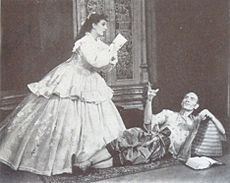
Brynner's role as King Mongkut in The King and I became his most famous part. He played the King 4,625 times on stage! He was in the first show in 1951. He also performed in later tours and revivals, including one in London in 1979 and another on Broadway in 1985. He won a Tony Award for Best Featured Actor in a Musical for his first Broadway performance. He received a special Tony for his last run.
He played the King again in the 1956 movie version. For this, he won an Academy Award for Best Actor. He also played the King in Anna and the King, a TV show in 1972. Brynner is one of only ten people to win both a Tony and an Academy Award for the same role.
In 1951, Brynner shaved his head for The King and I. After the show and movie became huge hits, he kept his head shaved for the rest of his life. Sometimes he wore a wig for other roles. His shaved head was unusual then and made him look unique. Some fans even shaved their heads to copy his "Yul Brynner look."
His second movie was The King and I (1956) with Deborah Kerr. It was a huge success.
The director Cecil B. DeMille chose Brynner to play Ramesses II in The Ten Commandments (1956). He starred opposite Charlton Heston. DeMille saw him in The King and I and knew he was perfect for the role. Brynner also starred in Anastasia (1956) with Ingrid Bergman. Both movies were big hits. Brynner became one of the most sought-after stars in Hollywood.
He then starred in The Brothers Karamazov (1958), which was also successful. He played Jean Lafitte in The Buccaneer (1958) with Charlton Heston.
Some of his other films in the late 1950s included The Journey (1959) and The Sound and the Fury (1959). He also replaced another actor in Solomon and Sheba (1959) with Gina Lollobrigida. This movie was a huge hit.
Action Roles in the 1960s
Brynner tried comedy with two films in 1960, Once More, with Feeling! and Surprise Package, but they weren't very popular.
He was well-liked in The Magnificent Seven (1960), a Western movie. This film was not a big hit at first in the U.S. However, it became very popular in Europe and is still loved today. Its success led to Brynner signing a deal for three more movies. The film was especially popular in the Soviet Union.
Brynner then focused on action films. He made Escape from Zahrain (1962) and Taras Bulba (1962) with Tony Curtis. These films were not as successful.
His films under the new deal included Flight from Ashiya (1963) and Kings of the Sun (1963). Neither was very popular. Other films like Invitation to a Gunfighter (1964) and Morituri (1965) with Marlon Brando also didn't do well.
Brynner had a hit with Return of the Seven (1966), where he played his role from the original Magnificent Seven again. Other films like Triple Cross (1966), The Double Man (1967), and The Long Duel (1967) were less popular.
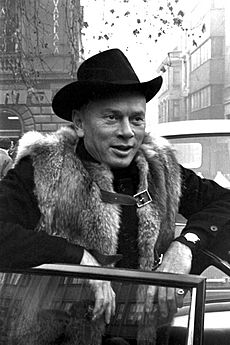
He starred in a war film in Yugoslavia, Battle of Neretva (1969). He also appeared in The Madwoman of Chaillot (1969). Brynner had a small, uncredited role as a singer in the comedy The Magic Christian (1969).
Later Career and Iconic Roles
Brynner went to Italy to make a Western film, Adiós, Sabata (1970). He also supported Kirk Douglas in The Light at the Edge of the World (1971). He continued to play lead roles in Romance of a Horsethief (1971) and the Western Catlow (1971).
He had a small role in Fuzz (1972). Then he played his most famous part again in the TV series Anna and the King (1972), which had 13 episodes.
After a film in Europe, Night Flight from Moscow (1973), Brynner created another famous role. He played 'The Gunslinger', a killer robot, in the popular film Westworld (1973). His next two films, The Ultimate Warrior (1975) and Futureworld (1976), were similar to this role.
Brynner returned to Broadway in a musical called Home Sweet Homer, which was not successful. His last movie was Death Rage (1976), an Italian action film.
Personal Life and Family
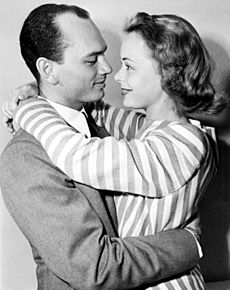
Yul Brynner became a U.S. citizen in 1943 when he was 22. However, in 1965, he gave up his U.S. citizenship in Switzerland. He did this because he had tax issues from living and working abroad for too long.
His son, Rock Brynner, wrote a book in 2006 about his father and family history. Rock often visits Vladivostok, his father's birthplace, for a film festival.
Health and Final Performances
In September 1983, Brynner had a sore throat. Doctors found a lump on his vocal cords. Just hours before his 4,000th performance in The King and I, he learned he had lung cancer. His throat was not affected, but the cancer was inoperable. He had to take a few months off for radiation therapy. This treatment damaged his throat, making it hard for him to sing or speak easily. The musical tour then continued.
In January 1985, the tour came to New York for a farewell Broadway run. The King and I played from January to June 1985. His last performance, a few months before he passed away, was his 4,625th time playing the King.
Other Interests and Talents
Besides acting and directing, Brynner was a talented photographer. He also wrote two books. His daughter Victoria created a book of his photographs. It included pictures of his family, friends, and other actors. He also took photos while working as a special consultant for the United Nations on refugees.
Brynner wrote Bring Forth the Children: A Journey to the Forgotten People of Europe and the Middle East (1960). He also wrote The Yul Brynner Cookbook: Food Fit for the King and You (1983).
He was also a skilled guitarist and singer. In his early years in Europe, he often played and sang gypsy songs in Paris nightclubs. He sang some of these songs in the movie The Brothers Karamazov. In 1967, he released an album called The Gypsy and I: Yul Brynner Sings Gypsy Songs.
Marriages and Children
Yul Brynner was married four times. His first three marriages ended in divorce. He had three biological children and adopted two.
His first wife was actress Virginia Gilmore (1944–1960). They had one son, Yul "Rock" Brynner (born 1946). Rock is a historian, novelist, and university lecturer.
His second wife was Doris Kleiner (1960–1967), a Chilean model. They had one daughter, Victoria Brynner (born 1962). Her godmother was the famous actress Audrey Hepburn.
His third wife was Jacqueline Simone Thion de la Chaume (1971–1981), a French socialite. Brynner and Jacqueline adopted two children from Vietnam: Mia (1974) and Melody (1975).
On April 4, 1983, Brynner married his fourth wife, Kathy Lee (born 1957). She was a ballerina from Malaysia. They met during a production of The King and I. They were married for the last two years of his life.
Death and Legacy
Yul Brynner passed away from lung cancer on October 10, 1985, in New York Hospital. He was 65 years old. His body was cremated, and his ashes were buried in a monastery in France.
Remembered in Russia
On September 28, 2012, a statue of Yul Brynner was put up in Vladivostok, Russia. It is 2.4 meters tall and stands in front of the house where he was born. The city of Vladivostok donated the land for the park. The mayor and Yul's son, Rock, were at the ceremony.
The Briner family's old cottage in Vladivostok is now a Yul Brynner museum.
Honors in the U.S.
In 1956, Brynner put his handprints and footprints in the concrete at Grauman's Chinese Theatre in Hollywood, California. In 1960, he received a star on the Hollywood Walk of Fame at 6162 Hollywood Boulevard.
In 2022, a podcast was started to celebrate his movies, called "Here's Looking at Yul, Kid."
Connection to France
Brynner lived, studied, and worked in France for many years. He wanted to be buried there. His resting place at fr:Abbaye royale Saint-Michel de Bois-Aubry has a special mention dedicated to him.
Filmography
| Year | Title | Role | Notes |
|---|---|---|---|
| 1949 | Port of New York | Paul Vicola | |
| 1956 | The King and I | King Mongkut of Siam | Won Academy Award for Best Actor Won National Board of Review Award for Best Actor (also for Anastasia and The Ten Commandments) |
| The Ten Commandments | Ramesses | Won National Board of Review Award for Best Actor (also for The King and I and Anastasia) | |
| Anastasia | General Sergei Pavlovich Bounine | Won National Board of Review Award for Best Actor (also for The King and I and The Ten Commandments) | |
| 1958 | The Brothers Karamazov | Dmitri Karamazov | |
| The Buccaneer | Jean Lafitte | ||
| 1959 | The Journey | Russian Major Surov | |
| The Sound and the Fury | Jason Compson | ||
| Solomon and Sheba | Solomon | ||
| 1960 | Once More, with Feeling! | Victor Fabian | |
| Testament of Orpheus | L'huissier / Court usher | Uncredited | |
| Surprise Package | Nico March | ||
| The Magnificent Seven | Chris Larabee Adams | ||
| 1961 | Goodbye Again | Extra in nightclub scene | Uncredited |
| 1962 | Escape from Zahrain | Sharif | |
| Taras Bulba | Taras Bulba | ||
| 1963 | Kings of the Sun | Chief Black Eagle | |
| 1964 | Flight from Ashiya | Sgt. Mike Takashima | |
| Invitation to a Gunfighter | Jules Gaspard d'Estaing | ||
| 1965 | Morituri | Captain Mueller | |
| 1966 | Cast a Giant Shadow | Asher Gonen | |
| The Poppy Is Also a Flower | Colonel Salem | (also titled Danger Grows Wild) | |
| Return of the Seven | Chris Adams | ||
| Triple Cross | Baron Von Grunen | ||
| 1967 | The Double Man | Dan Slater / Kalmer | |
| The Long Duel | Sultan | ||
| 1968 | Villa Rides | Pancho Villa | |
| 1969 | The File of the Golden Goose | Peter Novak | |
| Battle of Neretva | Vlado (Vladimir Smirnov) | ||
| The Madwoman of Chaillot | The chairman | ||
| The Magic Christian | Cabaret Singer | Uncredited | |
| 1970 | Adiós, Sabata | Sabata / Indio Black | |
| 1971 | The Light at the Edge of the World | Jonathan Kongre | |
| Romance of a Horsethief | Captain Stoloff | ||
| Catlow | Catlow | ||
| 1972 | Fuzz | The Deaf Man | |
| 1972 | Anna and the King | King Mongkut of Siam | TV series, 13 episodes |
| 1973 | Night Flight from Moscow | Col. Alexei Vlassov | |
| Westworld | The Gunslinger | ||
| 1975 | The Ultimate Warrior | Carson | |
| 1976 | Futureworld | The Gunslinger | |
| Death Rage | Peter Marciani |
Short subjects:
- On Location with Westworld (1973)
- Lost to the Revolution (1980) (narrator)
Box Office Popularity
During his most popular years, movie theaters voted Brynner as one of the top stars:
- 1956 – 21st most popular in the U.S.
- 1957 – 10th most popular in the U.S. and UK
- 1958 – 8th most popular in the U.S.
- 1959 – 24th most popular in the U.S.
- 1960 – 23rd most popular in the U.S.
Stage Work
- Twelfth Night (1941) (Broadway)
- Lute Song (1946) (Broadway and U.S. tour)
- The King and I (1951) (Broadway and U.S. tour)
- Home Sweet Homer (1976) (Broadway)
- The King and I (1977) (Broadway, London, and U.S. tour)
- The King and I (1985) (Broadway)
Awards and Recognition
- In 1952, he won the Tony Award for Best Featured Actor in a Musical for playing the King in The King and I. In 1985, he received a special Tony Award for his 4,625 performances in the show.
- He won the 1956 Academy Award for Best Actor for his role as the King of Siam in the movie The King and I. He was also named one of the "Top 10 Stars of the Year" in both 1957 and 1958.
- In 1960, he received a star on the Hollywood Walk of Fame for his work in motion pictures.
See also
 In Spanish: Yul Brynner para niños
In Spanish: Yul Brynner para niños






